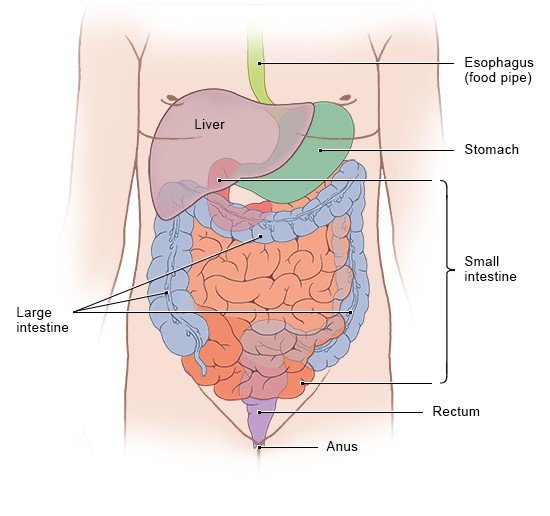The intestine (bowel) is a winding muscular tube extending from the stomach to the anus. Its main purpose is to digest food. But the intestine is not only there for digestion: It also produces various hormones that carry messages to other parts of the body, and plays an important role in fighting germs and regulating water entering and leaving the body. There is a particularly high number of nerves in the wall of the intestine. For some people, the intestine reflects how they are feeling: For instance, they might get a stomach ache, diarrhea or constipation when they are stressed or upset about something.
The intestine has two parts: the small intestine and the large intestine.
What happens in the small intestine?
The small intestine, which is directly connected to the stomach, is three to five meters long from one end to the other. It is made up of three sections known as the duodenum, jejunum and ileum.
In the small intestine, enzymes break down the different parts of foods – such as carbohydrates, proteins or fats – into their building blocks (sugars, amino acids and fatty acids). These enzymes are produced in the salivary glands in the mouth, in the stomach and in the pancreas. Bile fluid and intestinal secretions are also released. They help the enzymes to break down food. The digestive enzymes from the pancreas and the bile fluid are released in the intestine. The stomach and the intestine also produce mucus, which prevents the enzymes from attacking the mucous linings. The partially digested food, the various digestive juices and the mucus are then mixed with a lot of fluids, so the contents of the small intestine become very liquidy.
The inside wall of the small intestine has folds in it, like the body of an accordion. This makes the surface area very big. The wall of the small intestine mostly absorbs nutrients, vitamins and salts. From there, the nutrients enter the bloodstream and are carried to all of the body's organs. Much of the fluid is also absorbed at this point.
The wall of the small intestine also produces various hormones. These hormones influence things like the production of bile or pancreatic juice. The hormones also send the message to your brain that you are full.
What does the large intestine do?
In the right lower belly, the small intestine leads into the large intestine, which is roughly 1 to 1.5 meters long. The large intestine is made up of the cecum, the appendix, the colon and the rectum, which ends at the anus in the anal canal.
Another important task performed by the large intestine is the absorption of even more water, as well as salts. This helps to solidify the digested food to stool (poo). The muscles in the walls of the large intestine create strong, wave-like movements that help to push the contents of the intestine towards the anus. The urge to empty your bowels is triggered when stool enters the rectum. If we suppress this urge, the rectum temporarily stores the stool.
How often bowel movements occur varies greatly from person to person: Some people go three times a day, and others go three times a week. Both are completely normal. The frequency depends on various factors, including how much fiber you get in your diet.
The large intestine is also responsible for the absorption and production of vitamins. This job is done by gut microbes ("gut flora") – billions of bacteria that eat the undigested food matter. The bacteria produce the essential vitamins B and K, and prevent other (harmful) types of bacteria from settling in the intestine and multiplying there.
What happens when we have diarrhea or are constipated?
Two important jobs of the intestine are
- creating muscle movements that move the contents of the intestine towards the anus, and
- absorbing water and salts in the large intestine.
If one or both of these jobs isn't done properly, it can cause digestion problems: Constipation is usually caused by sluggish movements of the muscles in the large intestine. The contents of the intestine then move forward only very slowly. As a result, the stool gets more solid and harder as water is removed from it.
Diarrhea is caused by the opposite: The large intestine is no longer able to remove enough water from the stool. This can happen if too much liquid is passed on from the small intestine or if the contents of the intestine move too quickly through the large intestine. Intestinal infections are a common cause of diarrhea too.
Brandes R, Lang F, Schmidt R. Physiologie des Menschen: mit Pathophysiologie. Berlin: Springer; 2019.
Lippert H. Lehrbuch Anatomie. Munich: Urban und Fischer; 2017.
Menche N. Biologie Anatomie Physiologie. Munich: Urban und Fischer; 2023.
Pschyrembel Online. 2025.
IQWiG health information is written with the aim of helping people understand the advantages and disadvantages of the main treatment options and health care services.
Because IQWiG is a German institute, some of the information provided here is specific to the German health care system. The suitability of any of the described options in an individual case can be determined by talking to a doctor. informedhealth.org can provide support for talks with doctors and other medical professionals, but cannot replace them. We do not offer individual consultations.
Our information is based on the results of good-quality studies. It is written by a team of health care professionals, scientists and editors, and reviewed by external experts. You can find a detailed description of how our health information is produced and updated in our methods.
Stay informed
Subscribe to our newsletter or newsfeed. You can find our growing collection of films on YouTube.

